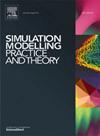云边缘协同iov中的计算卸载和任务缓存:一种多目标进化算法
IF 3.5
2区 计算机科学
Q2 COMPUTER SCIENCE, INTERDISCIPLINARY APPLICATIONS
引用次数: 0
摘要
随着车联网的快速发展,各种计算密集型的车载应用对车辆有限的计算资源提出了巨大的挑战。为了改善车载应用程序的用户体验,新兴的车辆边缘计算(VEC)将任务卸载到路边边缘服务器。然而,车辆之间的通信和计算资源竞争是不可避免的。如何对车辆进行最优的任务卸载决策,以减少延迟,平衡服务器负载,节约能源,是值得深入研究的问题。本文首先设计了一种车对车(V2V)通信路径获取算法,并引入了一种任务缓存机制,将部分已完成的应用和相关代码缓存到边缘服务器上。然后,提出了一种具有联合任务缓存机制的车联网边缘云协同模型。为了获得该问题的近最优解,我们设计了一种基于联合任务缓存和边缘云计算决策算法的多目标进化算法(jtcc - moea /D),以最大化车辆的效用。最后,利用TOPSIS (Order Preference by Similarity to a Ideal Solution)方法对该算法进行了评价。仿真结果表明,该算法能够实现车辆的最优卸车。本文章由计算机程序翻译,如有差异,请以英文原文为准。
Computation offloading and task caching in the cloud–edge collaborative IoVs: A multi-objective evolutionary algorithm
With rapid development of Internet of Vehicles (IoVs), various computation-intensive vehicular applications impose great challenges on the limited computing resources of vehicles. To improve the user experience of vehicular applications, the emerging vehicular edge computing (VEC) offloads tasks to roadside edge servers. However, competition over communication and computing resources is inevitable among vehicles. How to make optimal task offloading decisions for vehicles, so as to reduce delay, balance server load and save energy, is worth researching in-depth. In this paper, first, a vehicle-to-vehicle (V2V) communication path acquisition algorithm is designed, and a task caching mechanism introduced which cache some completed applications and related codes on the edge server. Then, a vehicular networking model with joint task caching mechanism for edge–cloud collaboration is proposed. To obtain the near-optimal solutions to this problem, we design a multi-objective evolutionary algorithm based joint task caching and edge–cloud computing decision algorithm (JTCEC-MOEA/D) to maximize the utilities of vehicles. Finally, the proposed algorithm is evaluated by the Technique for Order Preference by Similarity to an Ideal Solution (TOPSIS) method. The simulation results show that the proposed algorithm can make optimal task offloading-making for vehicles.
求助全文
通过发布文献求助,成功后即可免费获取论文全文。
去求助
来源期刊

Simulation Modelling Practice and Theory
工程技术-计算机:跨学科应用
CiteScore
9.80
自引率
4.80%
发文量
142
审稿时长
21 days
期刊介绍:
The journal Simulation Modelling Practice and Theory provides a forum for original, high-quality papers dealing with any aspect of systems simulation and modelling.
The journal aims at being a reference and a powerful tool to all those professionally active and/or interested in the methods and applications of simulation. Submitted papers will be peer reviewed and must significantly contribute to modelling and simulation in general or use modelling and simulation in application areas.
Paper submission is solicited on:
• theoretical aspects of modelling and simulation including formal modelling, model-checking, random number generators, sensitivity analysis, variance reduction techniques, experimental design, meta-modelling, methods and algorithms for validation and verification, selection and comparison procedures etc.;
• methodology and application of modelling and simulation in any area, including computer systems, networks, real-time and embedded systems, mobile and intelligent agents, manufacturing and transportation systems, management, engineering, biomedical engineering, economics, ecology and environment, education, transaction handling, etc.;
• simulation languages and environments including those, specific to distributed computing, grid computing, high performance computers or computer networks, etc.;
• distributed and real-time simulation, simulation interoperability;
• tools for high performance computing simulation, including dedicated architectures and parallel computing.
 求助内容:
求助内容: 应助结果提醒方式:
应助结果提醒方式:


